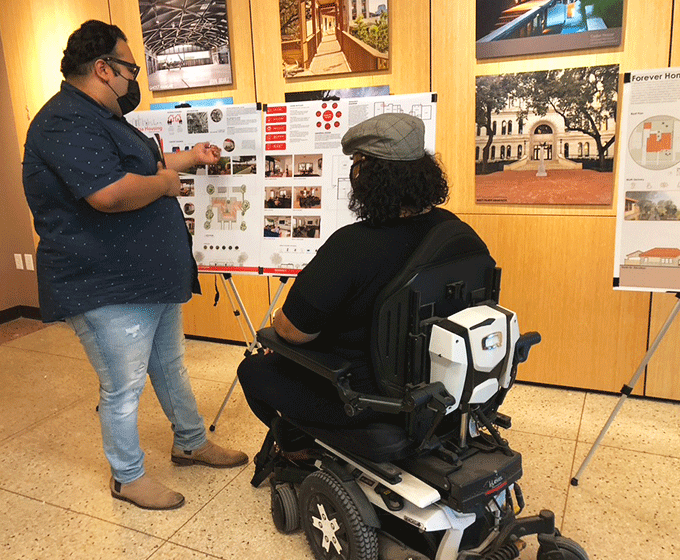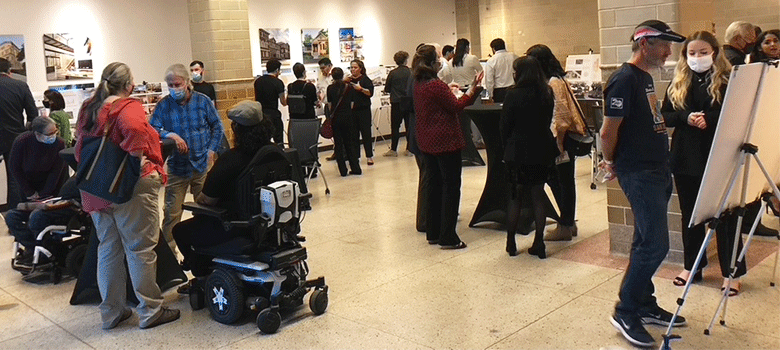
Architecture graduate student Daniel Hernandez talks with a disabled guest about his creation, a universal design living space for a duplex environment, at a reception at the AIA Center for Architecture.
DECEMBER 14, 2021 — A select group of UTSA architecture graduate students is poised to make a societal impact designing better living spaces for people with disabilities. The students are part of the Universal Design class taught by Neda Norouzi, assistant professor for the School of Architecture and Planning in the UTSA Margie and Bill Klesse College of Engineering and Integrated Design.
Norouzi believes that architecture should benefit everyone and that human-centered design is a way to encourage input from people in society who may otherwise be unheard.
“We extend this inclusive approach in the classroom, teaching future architects the importance of inclusive design and the impact of the built environment on people’s quality of life,” Norouzi explained.
Universal design (UD) is defined as the making of products and environments that are usable by all people, to the greatest extent possible, without the need for adaptation or specialized design.

UTSA architecture students displayed their universal design solutions recently at a reception at the AIA Center for Architecture. The reception was attended by people living with disabilities, as well as city officials, local architects, designers and professionals in the housing industry.
“The idea is to design a home that is functional for everyone, regardless of their age, physical abilities or stature,” Norouzi said.
A 2018 national survey conducted by the American Association of Retired Persons (AARP) indicates that 76% of people ages 55 and older prefer to live independently in their own home. However, only 50% of these homes meet the physical needs of people who choose to age in place.
In an effort to address this challenge, the City of San Antonio Disability Access Office (DAO), disABILITYsa and Successfully Aging and Living in San Antonio (SALSA) conducted a survey on how the COVID-19 pandemic affected the lives of San Antonians with disabilities. Nearly all respondents indicated negative impact to their social experience, healthcare and food access.
This semester, Norouzi’s students worked with disABILITYsa, an organization that amplifies the voices of people living with disabilities. Executive director Melanie Cawthon ’98, works directly with city housing officials to adapt UD concepts into building codes. Universal design construction typically includes widening halls and doorways, lowering countertop heights, making appliances and sinks accessible for wheelchair use and more. Retrofitting homes for universal design is typically more expensive than traditional remodeling, forcing many families to make sacrifices in their home environment and often suffer displacement.
Part of Cawthon’s strategy to control retrofitting costs includes networking with local architects and designers to think universal design first with all of their projects.
“My excitement about starting this next generation of architects from UTSA is connecting them with people living with disabilities and taking that experience with them into their careers,” Cawthon said. “Maybe their next project will be a universal design and we'll go from one house to 10 houses, to someday every house accessible by everyone.”
At the beginning of the fall 2021 semester, Norouzi randomly assigned students to five different scenarios that included a family situation and their living space. These scenarios included a single father with his young son who is blind, a family of three with a mom who is deaf, a young couple with a husband who uses an electrical wheelchair, a couple with a teen daughter with autism, and a young family of four who want to age in place. In this last scenario, the father is an emergency room physician who works long hours usually during the night shift, so he requires a dark and quiet room to sleep during the day. For them, a home remodeled with universal design will avoid costly retrofit if needed in the future.
“The design of these homes is based on research. Students reviewed the survey results conducted by disABILITYsa, then read and analyzed scholarly articles that were published in the last 10 years,” Norouzi said. “This led to better understanding the needs of San Antonians living with disabilities and then discovering how architecture can respond to some of those needs.”
An impactful moment came during a town hall meeting when students heard firsthand about the challenges faced by people with disabilities when searching for suitable housing or adapting to traditional designed spaces.
“When you think of American Disabilities Act compliance, it’s just about addressing the bare minimum. But universal design—it’s about being inclusive to everyone,” said Daniel Hernandez, who is pursuing his master’s degree in architecture.
“Though I was aware of universal design and its principles, taking a much more thorough look into it really opened my eyes to how much we as designers are falling short in providing good design for everyone, especially in residential design,” added Gerrah Brinkerhoff, another one of Norouzi’s students. “All the design decisions made in creating a house can greatly benefit the well-being of the individual who lives there along with anyone who may visit their home. Starting to make these decisions a normal practice is something that we need to do, not to just adhere to code, but to truly design for all.”
Hernandez, Brinkerhoff, and their fellow classmates displayed their universal design solutions at a reception by the UTSA School of Architecture and Planning and disABILITYsa.org at the AIA Center for Architecture. City officials, local architects, designers and professionals in the housing industry and people living with disabilities were among the attendees.
UTSA Today is produced by University Communications and Marketing, the official news source of The University of Texas at San Antonio. Send your feedback to news@utsa.edu. Keep up-to-date on UTSA news by visiting UTSA Today. Connect with UTSA online at Facebook, Twitter, Youtube and Instagram.
Move In To COLFA is strongly recommended for new students in COLFA. It gives you the chance to learn about the Student Success Center, campus resources and meet new friends!
Academic Classroom: Lecture Hall (MH 2.01.10,) McKinney Humanities BldgWe invite you to join us for Birds Up! Downtown, an exciting welcome back event designed to connect students with the different departments at the Downtown Campus. Students will have the opportunity to learn about some of the departments on campus, gain access to different resources, and collect some giveaways!
Bill Miller PlazaJoin us for an intimate evening of cocktails, conversation, and culinary inspiration with Pati Jinich, Emmy-nominated chef and James Beard Award-winning author. Enjoy light bites and signature drinks in the warm, modern setting of Mezquite as Pati connects with guests over her passion for Mexican cuisine and storytelling.
Mezquite Restaurant in Pullman Market, 221 Newell Ave., San Antonio 78215From inspired courses to thoughtful pairings and a rich sense of community, the Ven a Comer Signature Dinner is a night of shared meals, shared stories, and unforgettable flavor.
Stable Hall (Pear Brewery), 307 Pearl Pkwy, San Antonio 78215Come and celebrate this year's homecoming at the Downtown Campus with food, games, giveaways, music, and more. We look forward to seeing your Roadrunner Spirit!
Bill Miller PlazaThe University of Texas at San Antonio is dedicated to the advancement of knowledge through research and discovery, teaching and learning, community engagement and public service. As an institution of access and excellence, UTSA embraces multicultural traditions and serves as a center for intellectual and creative resources as well as a catalyst for socioeconomic development and the commercialization of intellectual property - for Texas, the nation and the world.
To be a premier public research university, providing access to educational excellence and preparing citizen leaders for the global environment.
We encourage an environment of dialogue and discovery, where integrity, excellence, respect, collaboration and innovation are fostered.